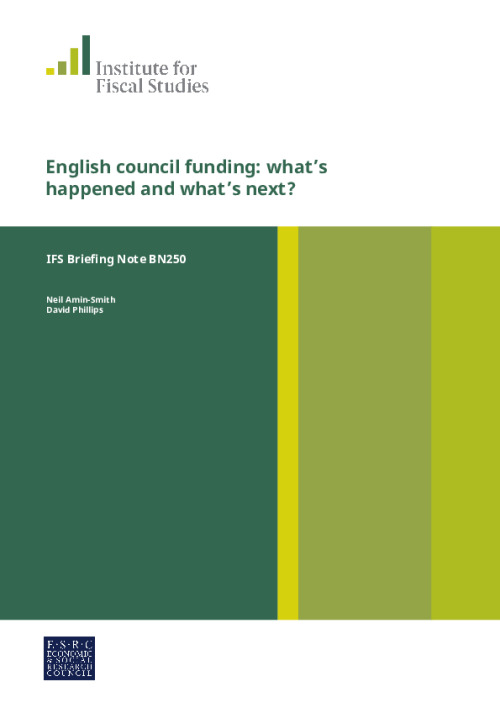We are in the midst of major changes to local government funding – both its level and the system for raising and distributing it. This note brings together some of the key findings of our research on this topic and highlights where to find further information.
- On average, local government spending on services has fallen by 21% in real terms since 2009–10. However, those cuts have not been equally distributed across the country, and have been larger in more deprived than more affluent areas. This pattern of cuts has meant that spending per person in the most deprived fifth of councils has fallen from 1.52 times to 1.25 times the level in the least deprived fifth between 2009-10 and 2017-18.
- Cuts have also varied significantly across services, with councils prioritising services like adult social care (down 5%) and children’s social care services (up 10%). In contrast spending on children’s and youth centres is down more than 60%, planning & development and housing down more than 50%, and highways & transport and cultural and leisure services down more 40%.
- Cuts to overall budgets seem to be ending. But revenues from council tax and business rates – the two sources councils are set to rely on for the vast bulk of their funding in future – are highly unlikely to keep pace with rising demands and costs for public services. For example, even if council tax were to be increased by 4.7% a year (which is the average increase this year) every year, adult social care could account for more than half of revenues from these taxes by the mid 2030s, even without increasing service provision. This would leave little in the way of additional revenues for other services, including children’s social care, public health and housing.
- This means either that we will have to accept lower levels of service provision or that councils will have to be provided with additional funding. This funding could be raised via national taxation and given to councils in the form of grants or by devolving additional tax revenues and powers to councils.
- If one wanted to devolve a significant additional revenue source to councils, then a local income tax looks to be the most sensible option and would give councils additional discretion to choose tax and spend levels. However, it would entail additional administration and compliance costs, and require a system to redistribute revenues from richer to poorer parts of the country. This is because some areas – such as Blackpool, Blackburn and Hull – could raise less than half the average revenue per person from a flat-rate local income tax, while other areas – such as richer parts of West London and Surrey – could raise more than twice the average.
- The government is already committed to increasing the proportion of business rates retained by councils to 75%, but this is being paid for by cutting grants to councils. At the same time, it is proposing some sensible reforms to the business rates retention scheme (BRRS), which include centralising the risk associated with challenges and appeals against businesses’ property valuations (which is a risk outside councils’ control). Big decisions remain about how frequently and fully to ‘reset’ the system to redistribute revenues according to spending needs – which involves a trade-off between providing incentives for revenue growth and helping to ensure councils can afford comparable services even if their business rates revenues perform very differently.
- In what it terms the Fair Funding Review, the government is also reviewing how it assesses spending needs and accounts for how much councils can raise themselves via council tax. Its proposals for council tax are broadly sensible, and plans to use spending needs formulas for social care services based off analysis of individual and small-area data are welcome.
- However, the statistical analysis the government has conducted is not, on its own, a good rationale for basing the spending needs formulas for a raft of other services (including environmental, planning & development, culture & leisure and housing services) on population only, as it has suggested. Indeed, determining councils’ spending needs is not simply a statistical exercise, but necessarily relies on contentious subjective judgements.
- Overall, big choices loom for local government – both on the level of funding, and how it is raised and distributed. Are we willing to accept higher taxes or cutbacks elsewhere to pay for the rising costs and demands for council services? How do we balance local discretion and incentives versus consistency in services across the country? Such questions do not have just one right answer, but we cannot continue to muddle on as we are. The reform of the local government finance system is not just a technical issue – it will have profound implications for the type of country England is.










